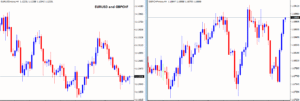Summary on Currency Correlation is an overview of what we covered in Previous lessons.

What currency pairs move in same / opposite direction? As a trader how is this important to you? etc.
Forex trading involves trading of currencies in pairs. Most of these economies depend on each other for trade and production.
This establishes a strong relationship between countries’ economies as well as their currencies.
Currency correlation shows how currencies are related to each other due to different factors such as location and economic factors.
WHAT IS CURRENCY CORRELATION?
Currency correlation Is a statistical measure of how currency pairs move in relation to each other.
It shows currency pairs that move in the same direction, opposite or completely random.
If different currency pairs share the same base or qoute currency, they are almost likely to move in the same direction.
However, if the base currency of a currency pair is the quote currency of the other pair, the two pairs will move in different directions.
On the other hand, if the two currency pairs have nothing in common, they will move randomly.
When you establish this kind of relationship, you will be able to measure the risk exposure of trading highly correlated currencies.
Therefore, let’s look at Summary on currency correlation coefficient
Correlation coefficient.
It is represented numerically on a scale between +1 and -1.
- (-1) represents negative correlation coefficient.
- ( +1) positive correlation coefficient.
- And (0) no correlation.
Positive correlation coefficient (+1), implies that two currency pairs will move in the same direction 100% all the time.
On the contrary, the negative correlation coefficient (-1), implies two currency pairs will move in opposite directions 100% all the time.
The correlation of zero implies that the relationship between the currency pairs is neutral. This means the movement between the two pairs completely random.
Currency pairs that move in the same direction
- EUR/USD and GBP/USD
- USD/CHF and USD/JPY
- EUR/USD and NZD/USD
- EUR/USD and AUD/USD
- NZD/USD and AUD/USD
Currency pairs that move in the opposite direction
- GBP/USD and USD/CHF
- EUR/USD and USD/CAD
- USD/CHF and NZD/USD
- AUD/USD and USD/JPY
- USD/CAD and AUD/USD
Why you should consider correlation before taking a trade?
Currency correlation helps you to know currencies that move in the same direction, opposite or just random.
In fact, If you trade multiple pairs which are strongly positively correlated or negatively correlated you expose your account to a double risk.
Therefore correlations helps you to eliminating double risk exposure.
You can also use currency correlation to predict the direction and movement of the other pair.
For instance, When one pair is showing a strong movement in its current direction, and the other is ranging. You can easily tell its next move.
Hedging. You can hedge one currency in a trade with another.
This can be done with Currencies that have strong negative correlation. Eg. EUR/USD and USD/CHF.
ATTRIBUTES OF A SUCCESSFUL TRADER
As i had promised to discuss the attributes of a successful forex trader. These are the most important of all. It's as simple as understanding the mechanisms of a predator. What hurts new traders is that they can not distinguish between facts and opinions and they end...
- Oh, bother! No topics were found here.



